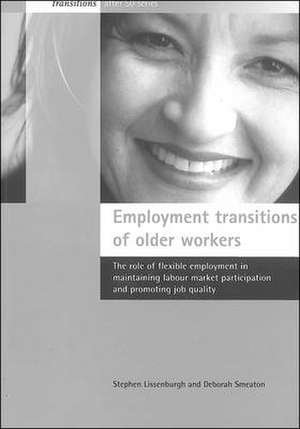Employment transitions of older workers – The role of flexible employment in maintaining labour mark et participation and promoting job quality: Transitions After 50 Series
Autor Stephen Lissenburghen Limba Engleză Paperback – 18 mar 2003
The experience of an abrupt and often premature departure from work can leave individuals feeling disorientated and disappointed and can prevent their valuable economic potential from being tapped. This report explores the possibilities of more flexible forms of work that bridge the gap between a steady career job and retirement. It examines such jobs in the wider context of the types of transition that are being made by people leaving work early. Transitions after 50 seriesPeople are living longer, yet increasingly are leaving working life well before the state retirement age. The Joseph Rowntree Fountain programme, Transitions after 50, explores people's experiences, decisions and constraints as they pass from active labour market participation in their middle years towards a new identity in later life. Reports in this series look in particular at issues about work, income and activities beyond work during this period of transition.For other titles in this series, please follow the series link from the main catalogue page.
Preț: 182.06 lei
Nou
Puncte Express: 273
Preț estimativ în valută:
34.84€ • 37.99$ • 29.38£
34.84€ • 37.99$ • 29.38£
Carte indisponibilă temporar
Doresc să fiu notificat când acest titlu va fi disponibil:
Se trimite...
Preluare comenzi: 021 569.72.76
Specificații
ISBN-13: 9781861344755
ISBN-10: 1861344759
Pagini: 52
Dimensiuni: 210 x 296 x 6 mm
Greutate: 0.23 kg
Editura: Bristol University Press
Seria Transitions After 50 Series
ISBN-10: 1861344759
Pagini: 52
Dimensiuni: 210 x 296 x 6 mm
Greutate: 0.23 kg
Editura: Bristol University Press
Seria Transitions After 50 Series
Recenzii
... readable and well-presented research findings of interest to students and policy-makers concerned with work-retirement transitions in the United Kingdom. Ageing & Society
Notă biografică
Stephen Lissenburgh, Policy Studies Institute and Deborah Smeaton, Policy Studies Institute
Cuprins
List of tables and figures
Acknowledgements
Summary
Acknowledgements
Summary
1. Employment transitions of older workers: introduction
The context: falling employment rates
Factors encouraging movement out of employment
Factors encouraging movement into flexible employment
The quality of flexible employment
The focus and method of the research
2. Movements out of permanent full-time employment
Introduction
Male exits from permanent full-time employment
Female exits from permanent full-time employment
Summary
3. Movements into flexible employment
Introduction
Movements into temporary employment
Movements into self-employment
Movements into part-time employment
Reduced hours
Summary
4. Flexible employment: good jobs or bad?
Introduction
Job quality
Stability
Training opportunities
Earnings
Jobs satisfaction
Supervisory or labour process control
Summary
5. Conclusions and policy implications
Conclusions
Policy implications
4. Flexible employment: good jobs or bad?
Introduction
Job quality
Stability
Training opportunities
Earnings
Jobs satisfaction
Supervisory or labour process control
Summary
5. Conclusions and policy implications
Conclusions
Policy implications
References
Appendix: Regression models of training and earnings

